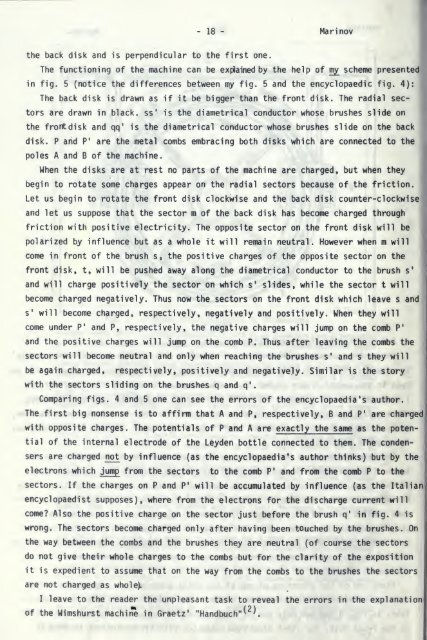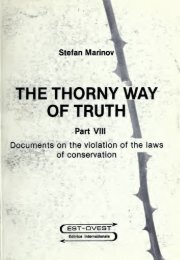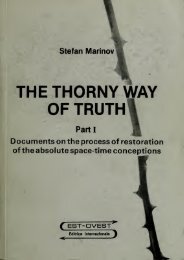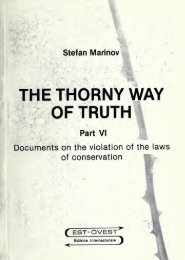The thorny way of truth : documents on the violation of ... - Mazeto.NET
The thorny way of truth : documents on the violation of ... - Mazeto.NET
The thorny way of truth : documents on the violation of ... - Mazeto.NET
Erfolgreiche ePaper selbst erstellen
Machen Sie aus Ihren PDF Publikationen ein blätterbares Flipbook mit unserer einzigartigen Google optimierten e-Paper Software.
- 18 - Marinov<strong>the</strong> back disk and is perpendicular to <strong>the</strong> first <strong>on</strong>e.<str<strong>on</strong>g>The</str<strong>on</strong>g> functi<strong>on</strong>ing <str<strong>on</strong>g>of</str<strong>on</strong>g> <strong>the</strong> machine can be explained by <strong>the</strong> help <str<strong>on</strong>g>of</str<strong>on</strong>g> m^ scheme presentedin fig. 5 (notice <strong>the</strong> differences between my fig. 5 and <strong>the</strong> encyclopaedic fig. 4):<str<strong>on</strong>g>The</str<strong>on</strong>g> back disk is drawn as if it be bigger than <strong>the</strong> fr<strong>on</strong>t disk. <str<strong>on</strong>g>The</str<strong>on</strong>g> radial sectorsare drawn in black, ss' is <strong>the</strong> diametrical c<strong>on</strong>ductor whose brushes slide <strong>on</strong><strong>the</strong> frortdisk and qq' is <strong>the</strong> diametrical c<strong>on</strong>ductor whose brushes slide <strong>on</strong> <strong>the</strong> backdisk. P and P' are <strong>the</strong> metal combs embracing both disks which are c<strong>on</strong>nected to <strong>the</strong>poles A and B <str<strong>on</strong>g>of</str<strong>on</strong>g> <strong>the</strong> machine.When <strong>the</strong> disks are at rest no parts <str<strong>on</strong>g>of</str<strong>on</strong>g> <strong>the</strong> machine are charged, but when <strong>the</strong>ybegin to rotate some charges appear <strong>on</strong> <strong>the</strong> radial sectors because <str<strong>on</strong>g>of</str<strong>on</strong>g> <strong>the</strong> fricti<strong>on</strong>.Let us begin to rotate <strong>the</strong> fr<strong>on</strong>t disk clockwise and <strong>the</strong> back disk counter-clockwiseand let us suppose that <strong>the</strong> sector m <str<strong>on</strong>g>of</str<strong>on</strong>g> <strong>the</strong> back disk has become charged throughfricti<strong>on</strong> with positive electricity. <str<strong>on</strong>g>The</str<strong>on</strong>g> opposite sector <strong>on</strong> <strong>the</strong> fr<strong>on</strong>t disk will bepolarized by influence but as a whole it will remain neutral. However when m willcome in fr<strong>on</strong>t <str<strong>on</strong>g>of</str<strong>on</strong>g> <strong>the</strong> brush s, <strong>the</strong> positive charges <str<strong>on</strong>g>of</str<strong>on</strong>g> <strong>the</strong> opposite sector <strong>on</strong> <strong>the</strong>fr<strong>on</strong>t disk, t, will be pushed a<str<strong>on</strong>g>way</str<strong>on</strong>g> al<strong>on</strong>g <strong>the</strong> diametrical c<strong>on</strong>ductor to <strong>the</strong> brush s'and will charge positively <strong>the</strong> sector <strong>on</strong> which s' slides, while <strong>the</strong> sector t willbecome charged negatively. Thus now <strong>the</strong> sectors <strong>on</strong> <strong>the</strong> fr<strong>on</strong>t disk which leave s ands* will become charged, respectively, negatively and positively. When <strong>the</strong>y willcome under P' and P, respectively, <strong>the</strong> negative charges will jump <strong>on</strong> <strong>the</strong> comb P'and <strong>the</strong> positive charges will jump <strong>on</strong> <strong>the</strong> comb P. Thus after leaving <strong>the</strong> combs <strong>the</strong>sectors will become neutral and <strong>on</strong>ly when reaching <strong>the</strong> brushes s' and s <strong>the</strong>y willbe again charged, respectively, positively and negatively. Similar is <strong>the</strong> storywith <strong>the</strong> sectors sliding <strong>on</strong> <strong>the</strong> brushes q and q*.Comparing figs. 4 and 5 <strong>on</strong>e can see <strong>the</strong> errors <str<strong>on</strong>g>of</str<strong>on</strong>g> <strong>the</strong> encyclopaedia's author.<str<strong>on</strong>g>The</str<strong>on</strong>g> first big n<strong>on</strong>sense is to affirm that A and P, respectively, B and P' are chargedwith opposite charges. <str<strong>on</strong>g>The</str<strong>on</strong>g> potentials <str<strong>on</strong>g>of</str<strong>on</strong>g> P and A are exactly <strong>the</strong> same as <strong>the</strong> potential<str<strong>on</strong>g>of</str<strong>on</strong>g> <strong>the</strong> internal electrode <str<strong>on</strong>g>of</str<strong>on</strong>g> <strong>the</strong> Leyden bottle c<strong>on</strong>nected to <strong>the</strong>m. <str<strong>on</strong>g>The</str<strong>on</strong>g> c<strong>on</strong>densersare charged not by influence (as <strong>the</strong> encyclopaedia's author thinks) but by <strong>the</strong>electr<strong>on</strong>s which jump from <strong>the</strong> sectors to <strong>the</strong> comb P' and from <strong>the</strong> comb P to <strong>the</strong>sectors. If <strong>the</strong> charges <strong>on</strong> P and P' will be accumulated by influence (as <strong>the</strong> Italianencyclopaedist supposes), where from <strong>the</strong> electr<strong>on</strong>s for <strong>the</strong> discharge current willcome? Also <strong>the</strong> positive charge <strong>on</strong> <strong>the</strong> sector just before <strong>the</strong> brush q' in fig. 4 iswr<strong>on</strong>g. <str<strong>on</strong>g>The</str<strong>on</strong>g> sectors become charged <strong>on</strong>ly after having been touched by <strong>the</strong> brushes. On<strong>the</strong> <str<strong>on</strong>g>way</str<strong>on</strong>g> between <strong>the</strong> combs and <strong>the</strong> brushes <strong>the</strong>y are neutral (<str<strong>on</strong>g>of</str<strong>on</strong>g> course <strong>the</strong> sectorsdo not give <strong>the</strong>ir whole charges to <strong>the</strong> combs but for <strong>the</strong> clarity <str<strong>on</strong>g>of</str<strong>on</strong>g> <strong>the</strong> expositi<strong>on</strong>it is expedient to assume that <strong>on</strong> <strong>the</strong> <str<strong>on</strong>g>way</str<strong>on</strong>g> from <strong>the</strong> combs to <strong>the</strong> brushes <strong>the</strong> sectorsare not charged as whole).I leave to <strong>the</strong> reader <strong>the</strong> unpleasant task to reveal <strong>the</strong> errors in <strong>the</strong> explanati<strong>on</strong><str<strong>on</strong>g>of</str<strong>on</strong>g> <strong>the</strong> Wimshurst machine in Graetz' "Handbuch"^^^








